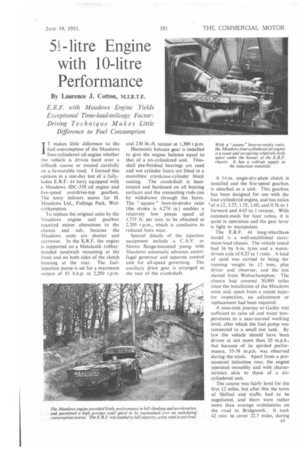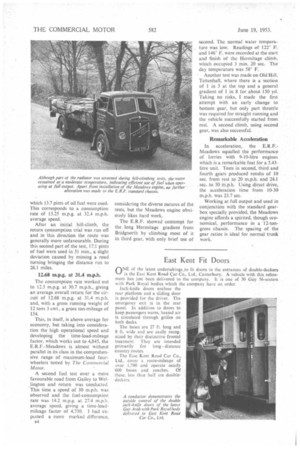litre Engine with 10-litre Performance
Page 37

Page 38

If you've noticed an error in this article please click here to report it so we can fix it.
By Laurence J. Cotton, M.I.R.T.E.
E.R.F. with Meadows Engine Yields Exceptional Time-load-mileage Factor: Driving Technique Makes Little Difference to Fuel Consumption
IT makes little difference to the fuel consumption of the Meadows four-eylindered oil engine whether the vehicle is driven hard over a difficult course or treated carefully on a favourable road. I formed this opinion in a one-day test of a fullyladen E.R.F. 44 lorry equipped with a Meadows 4DC-330 oil engine and live-speed overdrive-top gearbox. The lorry delivers stores for H. Meadows Ltd., Fallings Park, Wolverhampton.
To replace the original units by the Meadows engine and gearbox required minor alterations to the chassis and cab, because the Meadows units are shorter and narrower. In the E.R.F. the engine is supported on a Metalastik rubberbonded sandwich mounting at the front and on both sides of the clutch housing at the rear. The fuel. injection pump is set for a maximum output of 85 b.h.p. at 2,200 r.p.m. and 230 lb.-ft. torque at 1,300 r.p.m.
Harmonic balance gear is installed to give the engine balance equal to that of a six-cylindered unit. Thinshell pre-finished bearings are used and wet cylinder liners are fitted in a monobloc crankcase-cylinder block casting. The crankshaft is heattreated and hardened on all bearing surfaces and the connecting rods can be withdrawn through the bores. The !' square " bore-to-stroke ratio (the stroke is 4.274 in.) enables a relatively low piston speed of 1,735 ft. per min. to be obtained at 2,200 r.p.m., which is conducive to reduced bore wear.
Special details of the injection equipment include a C.A.V. or Simms flange-mounted pump with Meadows automatic advance, centrifugal governor and separate control unit for all-speed governing. The auxiliary drive gear is arranged at the rear of the crankshaft.
A 14-in, single-dry-plate clutch is installed and the five-speed gearbox is attached as a unit. This gearbox has been designed for use with the four-cylindered engine, and has ratios of 6,12, 3.27, 1.75, 1.00, and 0.76 to 1 forward and 4.65 to I reverse. With constant-mesh for four ratios, it is quiet in operation and the gear lever is light to manipulate.
The E.R.F. 44 long-wheelbase model is a well-established maximum-load chassis, The vehicle tested had 36 by 8-in. tyres and a wormdriven axle of 8.25 to 1 ratio, A load of sand was carried to bring the running weight to 12 tons, plus driver and observer, and the test started from Wolverhampton. The chassis had covered 30,000 miles since the installation of the Meadows units and, apart from a recent injector inspection, no adjustment or replacement had been required.
A nine-mile journey to Gailey was sufficient to raise oil and water temperatures to a near-normal working level, after which the fuel pump was connected to a small test tank. By Jaw the vehicle should have been driven at not more than 20 m.p.h., but because of its spirited performance, 35-38 m.p.h. was observed during the trials. Apart from a pronounced induction roar, the engine operated smoothly and with characteristics akin to those of a sixcylindered unit.
The course was fairly level for the first 12 miles, but after this the town of Shifnal and traffic had to be negotiated, and there were rather more than average undulations on the road to Bridgnorth. It took 42 min. to cover 22.7 miles, during which 13.7 pints of oil fuel were used. This corresponds to a consumption rate of 13.25 m.p.g. at 32.4 m.p.h. average speed.
After an initial hill-climb, the return consumption trial was run off and in this direction the route was generally more unfavourable. During this second part of the test, 17.1 pints of fuel were used in 51 min., a slight deviation caused by missing a road turning bringing the distance run to 26.1 miles.
12.68 m.p.g. at 31.4 m.p.h.
The consumption rate worked out to 12.3 m.p.g. at 30.7 m.p.h., giving an average overall return for the circuit of 12.68 m.p.g. at 31.4 m.p.h. and, with a gross running weight of 12 tons 3 cwt., a gross ton-mileage of 154.
This, in itself, is above average for economy, but taking into consideration the high operational speed and developing the time-load-mileage factor, which works out to 4,845. the E.R.F.-Meadows is almost without parallel in its class in the comprehensive range of maximum-load fourwheelers tested by The Commercial
Motor. .
A second fuel test over a more favourable road from Gailey to Wellington and return was conducted. This time a speed of 30 m.p.h. was observed and the fuel-consumption rate was 14.2 m.p.g. at 27.4 m.p.h. average speed, giving a time-loadmileage factor of 4,730. I had expected a more marked difference, ts4 considering the diverse natures of the tests, but the Meadows engine obviously likes hard work.
The E.R.F. showed contempt for the long Hermitage gradient from Bridgnorth by climbing most of it in third gear, with only brief use of second. The normal water temperature was low. Readings of 122° F. and 146' F. were recorded at the start and finish of the Hermitage climb, which occupied 3 min. 20 sec. The day temperature was 58° F.
• Another test was made on Old Hill, Tettenhall, where there is a section of 1 in 5 at the WI) and a general gradient of 1 in 8 for about 150 yd. Taking no risks, I made the first attempt with an early change to bottom gear, but only part throttle was required for straight running and the vehicle successfully started from rest. A second climb, using second gear, was also successful.
Remarkable Acceleration
In acceleration, the E.R.F.Meadows equalled the performance of lorries with 9-10-litre engines which is a remarkable feat for a 5.43litre unit. Tests in second, third and fourth gears produced results of 10 sec. from rest to 20 m.p.h. and 24.1 sec. to 30 m.p.h. Using direct drive, the acceleration time from 10-30 m.p.h. was 23.7 sec.
Working at full output and used in conjunction with the standard gearbox specially provided, the Meadows engine affords a spirited, though economical, performance in a 12-tongross chassis. The spacing of the gear ratios is ideal for normal trunk work.




















































































